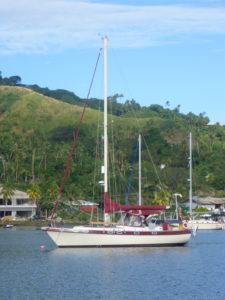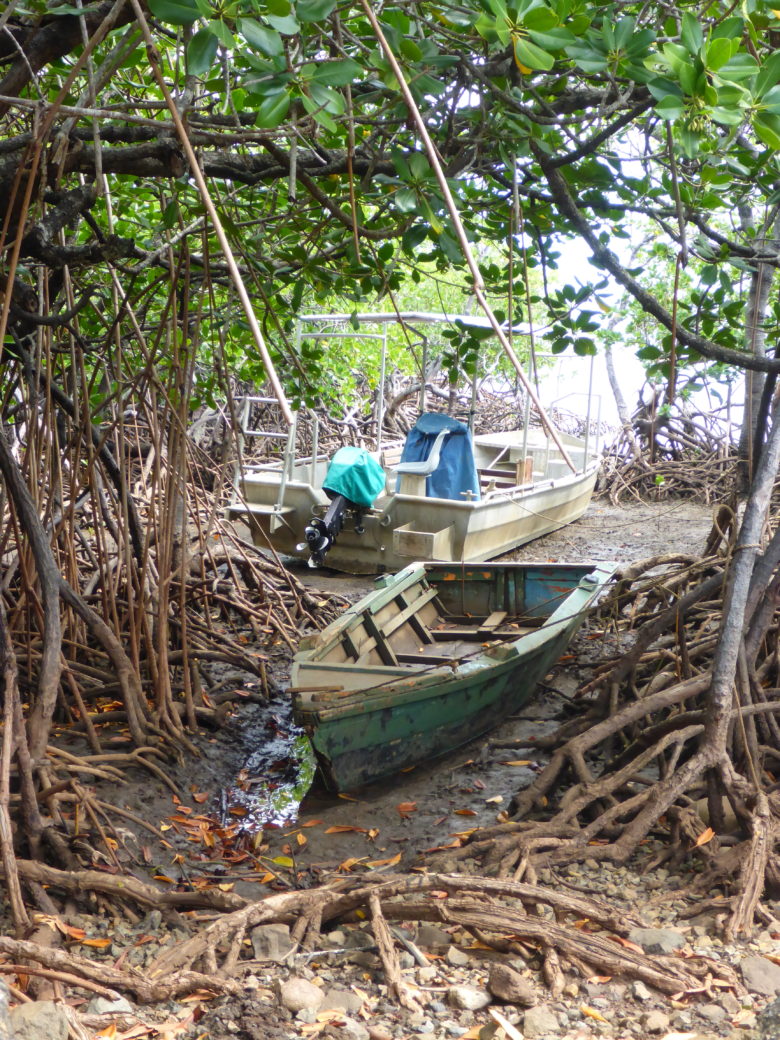Forward in a Suzuki 8 seater Minivan
They were David and Rekka from Pino who herald from Canada and create internet games on board for a living, Betsy and Ken from dark blue hulled Alcyone retirees from the US and Andreas and Birgit and Rob (driver) and me (side gun).
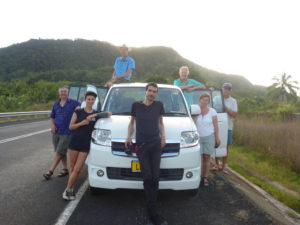
Monty at Budget sent us off with a gritty carpet and filmy windscreen but he was sweet and the air conditioning worked so we weren’t too bothered.
The snug little bus struggled up the steep slopes of the mountain range into lush rainforest and then over to a dryer climate with gentler winds on the north-west leeward side of the island.

I had asked Monty for the road map I saw sitting on his desk thinking he would have plenty of others. In fact the islands seem to have very few up to date maps and brochures for the likes of us ‘tourists’ and our road map was dated 2002. Monty had explained that there is little change in the roads that are sealed compared to the gravel tracks and then he reluctantly handed over his map!
So we swept into what we thought was a little town called Seaqaqa thinking we had over shot the track that led to Palmlea Lodge where we were planning to relax and have lunch. I could not have wanted for more help at the fuel station, three local Muslims wanted to assist. The oldest explained that although one might think this was Seaqaqa from the name on the supermarket and filling station this is the district of Seaqaqa, Labasa is also in this district. His town was Natua and we had a ways to go yet.
“Blue signs on the left” Julie had said on the phone and there they were as we were leaving Tabia. The track at first routed through fields of sugar cane, over a single file wooden bridge like those on the main road and then the scenery became prettier with tamarinds decorated with their long dangly giant legume seed pods, flowers growing on trees and on the ground near the munching teeth of a tethered steer looking mournful, possibly because of the painful looking weeping gash on his shoulder.

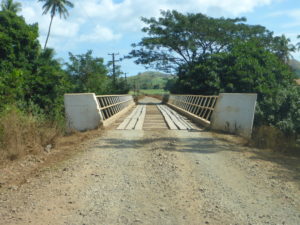
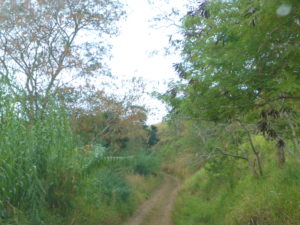

Up and down over little hills and there suddenly was the ocean to the north beyond Cacau Levu, The Great Sea Reef. Third largest barrier reef in the world after Curacao and the Australian Great Sea Reef.
Thirteen years ago after 60,000 miles at sea Julie and Joe, then aged 63 and 69 respectively, threw in the anchor, sold their latest boat Apogee and bought this tract of land. With the skills of the architect he is Joe personally designed and built a spacious lodge, with a kitchen designed along the lines of a ship’s galley because that’s how he liked them and a split level dining room lounge area open to the ocean.
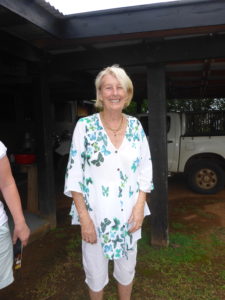
Being near the airport it is easy for their clientele to fly from all over the world to Nadi international on the other island, hop across here and be met at the airport by a smiling Julie. When we went there they had no guests until the weekend so they spent much time with us telling us about themselves and their lives.
Unwanted by his parents Joe was raised on a ranch in Oklahoma by good friends of his grandfather and his ‘dad’ instilled in him the will to achieve and be rewarded by success. They met in Malta shortly after Julie’s husband had succumbed to cancer as sadly Joe will soon as he is afflicted with both Alzheimer’s and lymphoma.
I had sent ahead by phone our lunch order to make life easier for them and while Julie’s two helpers worked away in the galley we all took a walk down to the jetty Joe built years ago that carried us over the mangrove swamp and out onto the lagoon waters. Back along the grassy track strewn with coconuts I chatted easily with Birgit about this and that. Sadly for rest of us, but not for the goat or me, home farmed goat was off the menu.
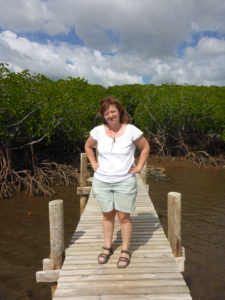
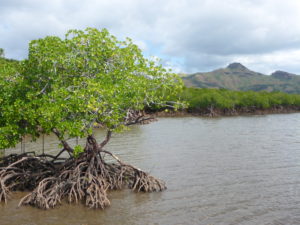
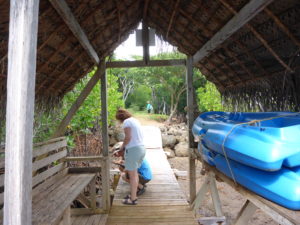

Julie served us with homemade iced lime juice on our return and then we lunched with each of them at either end of the table being the most charming and interesting hosts.



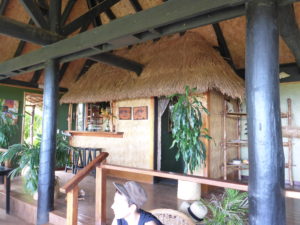

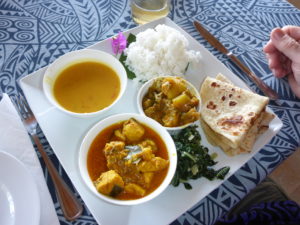
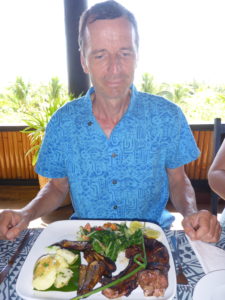
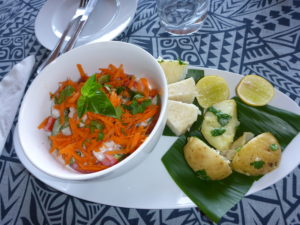
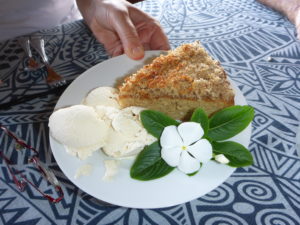
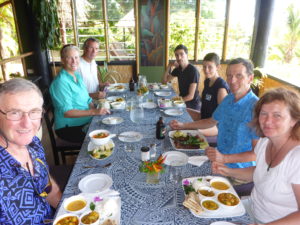
Then Betsy and Ken, Rob and I headed for the 25 metre lap pool for a refreshing dip with a view to the little islands that dot the reef. Joe wandered down and showed Betsy and I the lovely garden full with flowering trees and plants and one of the Bures, attractively furnished guest room huts with spacious en-suite accommodation and a private balcony.

Julie had plans for a luxury camping (Glamping?) area and next week work starts on a shower block near the pool.
After a quick tour of the Lodge we returned to the van where it was parked next to the wire-netted enclosed vegetable garden. Julie told us to pick any fruit or veg we liked knowing that as cruisers we are limited to small potted herb gardens on boats at best and I promised to put in a good word for them on Curly’s radio net the next morning.

All too soon because I could have spent a peaceful week there quite easily, we were on our way for a quick look at Labasa market before the two hour trek back to Savusavu, a cold beer at the bar and a pleasant wind down chat in the cool of the evening with our six friends.

A Long Way by Tender
Zoonie had passed the Jean-Michel Cousteau Dive Resort on our arrival at this island and there is a neat little anchorage there in an area clear or cleared of reef that cruising yachts are welcome to use for one night or so on arrival to or departure from here, we may well use it ourselves for the same reason and for another opportunity to snorkel.
Jean-Michel is Jacques Cousteau’s first son although in the past the two were at loggerheads over the management and policy of the elder’s Cousteau Society and when Jean-Michel set up on his own here his father sued him for using the family name. It’s all on Wiki.
Just beyond the anchorage there are a few coral heads and one has a split through it and so is called split rock. A few metres away is what used to be a red buoy but is now pale pink and we tied our tender to it after the longest trip we have ever done In our little boat lasting over 40 minutes. I was amazed there was enough petrol in the tank, in fact one quarter remained so with that and the reserve tank we knew we’d get back ok. We were prepared to move the dinghy if the Cousteau team returned and asked us to.

Rob suggested we flop over the side at the same time so as not to tip the dinghy but my flipper got stock under the inflated tube so there was an inelegant struggle from my side before we were both enjoying the black and white sergeant major fish that keenly awaited our arrival. Dozens of them surrounded us and started nipping us. They were after the breadcrumbs we had been told to bring. So with the bag now emptied into their little tummies they lost interest and we were allowed to go and explore.

The water was a little cloudy so I decided not to take the camera. The coral was badly damaged by Cyclone Winston and the sea bed was strewn with coral ‘bones’. What there was lacked a bright variety of colour and the most successful was the hard flat mats of ochre coloured coral that lay like throw overs on the ancient coral heads. Despite the loss of their habitat there were lots of tropical fish varying in size and colour.
The one that sticks out for me was about 8 inches long with a radial pattern of pastel colours on its head and a different pattern on its body. Was this a colour designed to attract a mate or more suited to its pre-Winston habitat I wondered. It was a six bar wrasse. I took this photo on a later snorkel expedition.

Back alongside the dinghy Rob had tied a red loop of rope to the side line so we could take a step before heaving ourselves back over the cushion at the end of our first snorkel trip in Fiji.
Bogiwalu – eight nights of wind.
Following on from our fishy adventure we took a taxi with Mark from Wavelength along the five minute ride to the Flora Tropica Gardens, near the Cousteau resort for some floral fun.
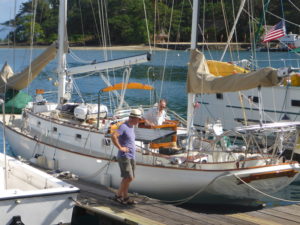
One of the questions I had for Enoch, the Garden Manager, was ‘what was the Fijian name for the period of strong wind we had arrived in?’ He explained that Bogi is Fijian for night and walu means eight and is relatively uncommon this time of year. Good we thought that gives our cruising plans a chance.

When I asked if there were any Sandalwood trees here as they were once a major export industry like the Kauri in NZ, he replied in the negative but explained that in various parts of the tropics GM Sandalwood and Mahogany saplings are being planted by the thousand for a quick growing crop to replace the original slow growing natural version of these fine ruddy hardwoods.
Enoch was a long line fisherman working out of Taiwan in a previous life and conserving nature instead of ravaging it is now his passion. A tall man he had a painfully swollen leg that was discoloured grey and could have been cellulitis and as Mark explained was made worse by his being overweight. He wore an open friendly expression and spoke with a quiet intelligence and I would have liked him to be our guide but it is a self-guided tour with a thoroughly researched double page small typeface guide, so off we went for nearly two hours of head craning and shared discussion, not all about the 200 palms that reside here.
Many of the palms are extinct in their natural habitat with one notable exception, the African Palm (used for palm oil). This as you know is being planted over millions of acres of slashed, cleared and burned prime rainforest, destroying the natural habitat of the few remaining animal and plant species that used to fill the tropical rainforests to abundance. Used for example in making biscuits for the world’s human sweet tooth. The only value is profit.
One of our first ‘finds’ was the fishtail palm with its many medicinal uses to do with the digestive tract from sore throats and mouth ulcers right through to its use as a laxative. Unlike the many others we were invited to touch, pick, bruise and smell this leaf!!


By way of a variation the mighty uplifted arms of the Baobab tree hold the title as being the new superfruit with its history of healing and sustaining humans in a literally delicious way. In liquid or dried form the essence of the tree has been described positively as citrus, pear, vanilla, grapefruit and caramel. Although a pesky and destructive beetle would not agree. The bucket on its trunk contains a pheromone designed to attract the male beetle who is then trapped in the bucket, unable to mate.


The Marquesan Palm is so rare it is on loan and arrived in its own travel bag and the Bottle Palm succumbed to the burrowing snouts of pigs in the wild.
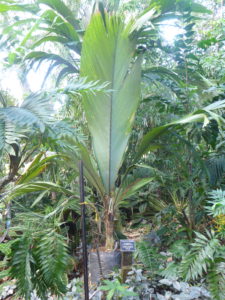
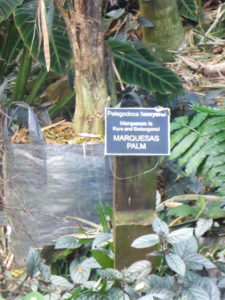
Anne in the red top was busy cutting lemons for her boss from the high branches of a tree when we first saw her but she came over for a chat and walked with us back to the gate. We tried and failed to reach a taxi driver by phone willing to come and collect us. Then Anne also tried and failed so we started walking back along the level bayside road.

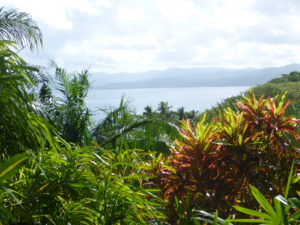
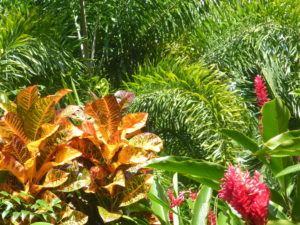
The gardens had been beautiful, a sanctuary to rare palms, but the homes and gardens at the start of the walk, before I thumbed down a taxi, were exquisite; I will let the photos speak for themselves.
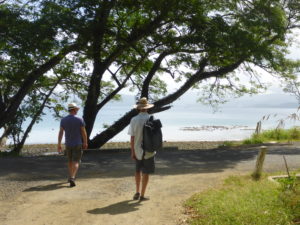
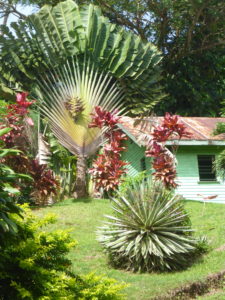

Sugarcane Harvest Time in Fiji
Lighting up in Labasa
This time meant getting up early and meeting Mark at the bus station to join the 7.30am bus load of school children, teachers marking the students work and business people off to the other side of the island.
Starting before daylight people were well into their working day locally as is common in these cooler hours in the tropics. I love that time of day too for writing and pottering between the chart table and galley.
The soil is so fertile that market gardening is a good life for farmers and the markets are full with a good variety of largely organic day fresh vegetables. The fields are neat with their rows of green plants growing. Goats graze everywhere, but not on the neat fields of course!
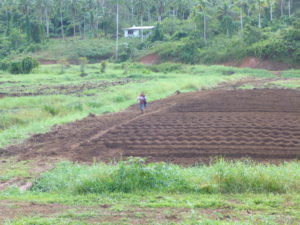
Back in 1945/6, long before my time you understand, when many Indian Muslims came here after Churchill’s Partition of India, the rural community must have found very similar conditions for farming as they had known back home. There seems to be a mixture of Fijian and Indian farmers and I wondered how well they get on together. Apparently if Fijians intermarry they lose their land ownership rights, I bet that causes problems.
I also wondered idly, as our little red bus struggled up over the mountain ridge that divides the island north to south, if we might see Julie from Palmlea Lodge again doing her shopping. Julie likes it because all she needs to purchase for her dream home and business, the Lodge, is there.
Visiting the city a couple of days before was a bit of a culture shock as one could hardly move for the crowds, it seemed to be like all the cruising sailor likes to get away from but I couldn’t wait to get back. The atmosphere was of friendly people working hard and lots going on to watch.
The ‘feel’ of a working community busy every day with the high demand for their inexpensive goods was invigorating. Of course there is struggle involved but comradeship as well, interchange and good humour. How much the willingly unemployed miss. How much more affluent supermarket societies miss. I’ve never been to India but this is like a small dose as the town is culturally more Indian than Fijian. I imagine that can cause tension between the two races as well.
A quick look around the market with Mark and we separated, agreeing to meet at the bus station again at 12.30pm for a taxi to the sugar mill.
Wandering down the shady side of the main street we noticed the sugar cane loads towed by lorries and tractors seemed to alternate, ones with cane lengths lashed down onto flat beds and those with cages full of shorter irregular shaped pieces. We would find out why later.
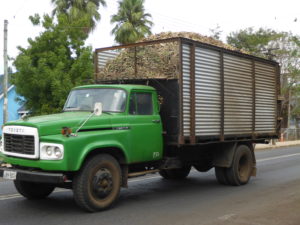
A young Indian man stepped out of a doorway on seeing us reading about the sugar cane juice drinks he was selling at The Juice Bar. “The sugar cane drink with ginger is very nice, you want to try some?” For $1fj we drank this refreshing and healthy (he claimed) drink that looked like a tiny glass of unfermented Guinness. It was really pleasant and refreshing and not too sweet at all.

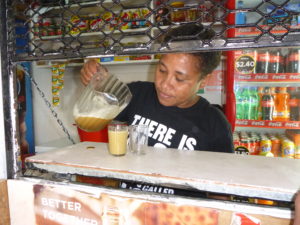
More of a look around confirmed that along with our previous visit after lunch at Palmea Lodge we pretty well knew the busiest end of the town so decided to try a coffee and cake in the Hare Krishna Restaurant. Its early days but my research so far suggests that these are a chain of loosely religiously based entirely vegetarian and partly vegan restaurants that are right up our street (!).

Not trying to overstate the case at all but these people are so congenial and friendly it makes a city visit a pleasure. We shared the cake and along with two coffees it came to $3.50fj (£1.30)

Back into the merry throng and a detour to the little railway track where it crosses the river to the mill. Then we wandered through a short mall and just as we were about to emerge Julie walked in (!) and we had a short chat. She was on her way to collect a TV aerial as she and Joe realised guests might like to view such things as sports, The Rugby World Cup for example, on their visits. I can see why she resisted for so long, their patch of paradise being an almost total escape from the rest of the world, but choice is also nice.
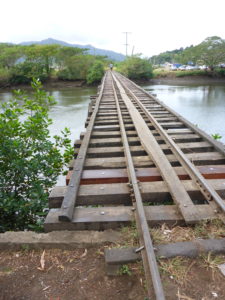
So back to the market for a more thorough exploration on top of the vast array of healthy fresh and colourful vegetables, peppers, fruit and spices, the latter being carefully sealed in little plastic bags using a single candle flame, whole leaves of locally grown tobacco, or torn strips wrapped in newspaper and smoked or rolled up and threaded onto wool.
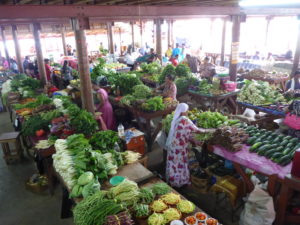


Wooden glazed cabinets full with layers of bronze, eagle winged dried fish and in plastic boxes piles of dried, ground kava ready for mixing with room temperature water and sieving through fine fabric to produce the lip numbing drink that is historically so popular here (and all over the southern hemisphere from the Indians of Ecuador westwards from what we could see) and now acts as an alternative to alcohol, which the Fijians cannot take like most indigenous people. The Kava drink as we made it and strained it through one of Rob’s socks, is bitter and tastes slightly of aniseed.
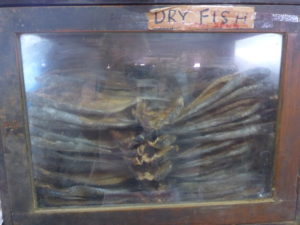
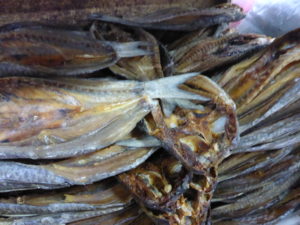
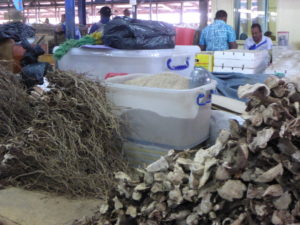
Somebody, probably Curly, told us about the new Handicrafts Market opened two years ago on the top floor of the market. Reaching the top of the stairs there are tables along the side where a lady was decorating the side ends of a woven matt with a trim of looped wool in a variety of bright colours. The pattern she was creating was not immediately obvious. We chatted and I took a photo and it was the photo that revealed the dramatic diagonal pattern she was creating, even she was impressed with what she and the camera lens had achieved.

A young girl stood beside a table of intricate garlands of flowers twisted and turned from leaf blades and dyed bright colours lying on a base of pale yellow matting. We decided to buy one on our return from the Sugar Mill in the two hours we thought we’d have free for some leisurely shopping. The young lady said she and her mum would be there until 5.00pm.

A quick snack of dried peas in their little candle flame sealed bag and Indian vegetable nibbles deep fried in breadcrumbs and washed down with boat water and we were ready for Mark and the taxi.
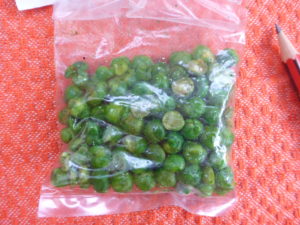
Things Become Crystal Clear
It had taken some organising with Jaswan, senior employee of the Fiji Sugar Corporation Mill, 5 minutes by taxi north east out of Labasa (pron: Lanbasa), but finally he was ready to show us around. He started at the mill as an apprentice 14 years ago and there wasn’t much he didn’t know. This is one of four mills in Fiji incorporated in 1972 with the Government holding 68% of the shares and employing 3000 people directly, in total. Another 200,000 or more people depending on it for their livelihood, mainly farming the rural sugar belts of Fiji.
The action started after an entertaining two hour wait sitting at the main gate watching the 100 or so queue of trailer loads of cane, some hand machete cut to measured lengths from the hillsides and shorter lengths of caged loads severed by one of the 20 mill owned machines working on the flatlands, all waiting patiently to move through to the weighbridge.

I now reflect on our good fortune of that afternoon because the six month harvest season is in full swing, the mill working flat out 24/7 to get the raw cane milled ready for shipment to Lautoka on the other island for packing and shipping onto the world market. Much of Europe is now sugar independent, including the UK with its beet production, so ex-colony but still Commonwealth member Fiji has had to do some careful marketing to stay in business. We saw it all at their busiest time of production.
The loads of raw cane are brought to the waiting lane by the farmers driving well loved and cared for Massey Ferguson tractors and Toyota trucks painted so thoroughly they look like new, wheel hubs spray painted silver and one even had red painted nuts. Production is now in a kinder paced, post slavery era of small plantation land ownership. The drivers have to wait in their cabs overnight if there is a break down in production, as there had been the night before. They proceed to the ‘weigh in’ in a quota system, measuring the machined crop fairly with the hand chopped loads.
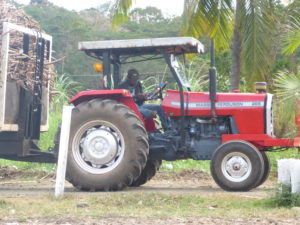
Despite being hot and tired almost every driver had a wave and welcome for us, as curious no doubt about these three distinctly white strangers as we were curious about their lives too.
On our bus ride in we had noticed the men working in the plantations west of Labasa and spotted the narrow gauge railway in use for over 100 years that still carts nearby loads into the mill from the more accessible plantations.
“Make sure your tunics are done up and your hats are tight” Jaswan warned, “The ground is uneven and watch your heads.”
“May I take photos?”
“You can but not for any publication.”
The factory is a mixture of old, newer and new production machinery and an international combination of design, manufacture and installation. Walking through areas where the noise and smell of industry worked alongside the history of rotting steelwork was something I had never come across before, being more used to old factories closing and completely new ones being built nearby. This process of gradual renewal maybe reduced the need for large scale investment and expensive loans.
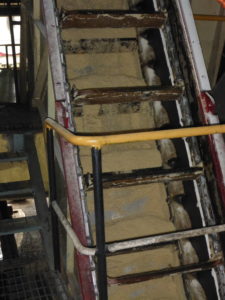
It also accounts for why there is no sugar museum, the factory is a working and transforming museum.
Near 600 employees keep the production going here this time of year and in the other six months, when the maintenance, repairs and building is done that number reduces by only one hundred. Nice work if you can get it.
All the helmeted workers we came across came forward to shake our hands as Jaswan introduced us.
We walked across the route taken by the trucks from the weighbridge to where their loads are tipped onto the conveyor belt that trundles up to the mighty (scary) crusher. The drivers’ vehicles are then re-weighed and the value of their load assessed, then they can go home, on this Friday 13th afternoon, Black Friday!
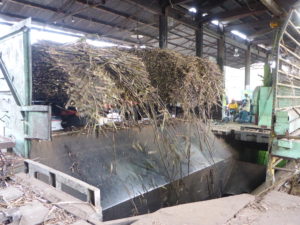
Watching the sugar juice pouring brown from the crushed stems was satisfying. The squeezed dry residue (bargasse, there’s a new one for you Scrabblers) is stockpiled into a flat topped mountain just outside and fuels the massive boiler to produce potentially enough electrical energy to power all of Fiji. In the control room we were introduced to two happy men who had pleasant but technical and responsible jobs controlling the machine, watching the numerous production monitors and generally working in a cool, clean, air-conditioned environment!

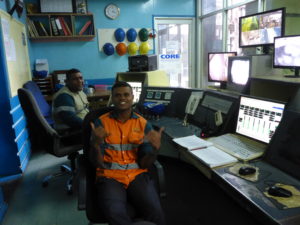
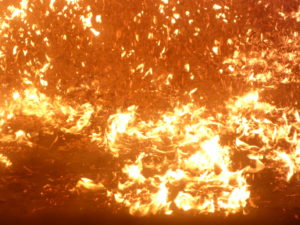
We explored the production process in the reverse order because that was the safest route in and back out for us. Up and down metal stairways, avoiding suspect puddles of liquid and ducking under hot pipes we couldn’t help but imagine that our visit would not have been allowed back in Health and Safety overly conscious Britain, so here we were very fortunate. At times the noise was so great Jaswan spoke to just one of us with the correct assumption we would exchange mental notes later.
After crushing, the liquid is washed, strained and cleared before being pumped into the evaporators. Jaswan opened a plug in the bottom of one and invited us to taste the sugar sticking to it. Soft brown sugar. Imagine the heat required from the boilers to evaporate all that liquid.
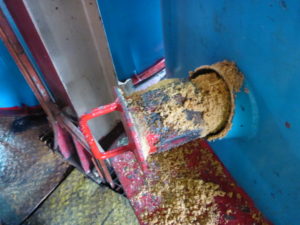
Then things really start to hot up when the sugar is boiled until the crystals are a regular shape.
Now here’s a job I could have been quite good at. Taking samples of the boiled sugar crystals, making a slide and looking at it under a microscope. Beautiful but uneven crystals in either square or rectangular shapes. They have to be even in size and shape before they are ready for shipment to the other island.
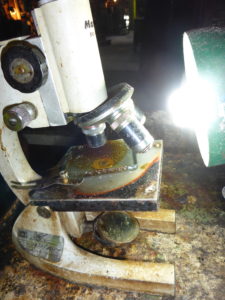
Then the uniformly shaped sugar crystals go into what look like centrifuges where it is spun to extract any moisture which becomes molasses.

Our tour ended in the generator room with the 10 megawatt (megabig!) beauty purring away nicely.

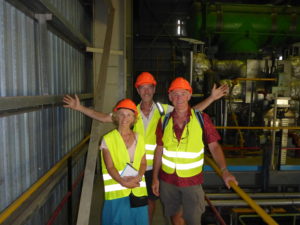
Then even more drama came our way. The school trip that we were due to accompany arrived and hour late and then Jaswan decided on conducting our personal tour after the school visit which accounts for our two hour wait sitting on benches at the entrance.
So instead of having two hours back in Labasa, making a planned purchase in the Handicraft market, enjoying a leisurely bite at the Hare Khrishna restaurant we had relaxed in before and generally being in plenty of time for the bus at 4.00pm, Jasman told us we would be quicker walking back into town because of the very slowly moving traffic queue working in the direction in which we needed to go rather quickly, it being 3.40pm already.
“No taxi will come out here with that queue.” He said when we asked if he could arrange one.
I can do it, I don’t like to but I can walk very quickly. Mark and I pondered for a few seconds on whether we would get back to the bus station before we spotted an empty taxi crawling along at my usual walking pace with many rests.
“We need to catch the 4.00pm bus for Savusavu please,” I said, then added “If we miss it would you be prepared to drive after it until we catch it?” Now he was my kind of guy, liked a challenge, the sort who’d struggle through a storm with you, maybe. So we relaxed nervously. Two smart school boys started walking our way so we could monitor how we would be doing had we walked. It was about even Stevens.
“There’s your bus,” the driver exclaimed with glee. We needn’t have worried, in the dense mass of moving humanoids it took us 20 minutes to get out of the bus station. I turned as I boarded the bus to see our man the taxi driver watching with concern and a smile to see we made it. A quick wave and he was gone.
The ‘air conditioning’ was on, doors and windows open and there wasn’t even standing room. People who were sitting could have their bags on their knees but the driver was strict on the folk who were standing to put bags in the racks so more could board.
A young school girl insisted I take her seat and this is common practice. My boys had to stand for the first half of the journey. School children have much respect for their elders. I was on a seat for three with a large lady on one side and a back pack pushing against my left shoulder, there was no more room in the racks.
All was well because we had made it. The driver adopted a no braking downhill policy, (well they would only overheat anyway I guess) which was interesting on the bends when my hand would grab the seat infront in perfect unison with the lady next to me and the boys knuckles turned white.
At one point little fingers gently tapped my arm, I turned and two lovely big brown eyes looked at me. I smiled back and said “Hello, what’s your name?” A little young to reply so I just held and gently shook her fingers by way of an ‘I’d like to be your teacher, kind of thing’.
As soon as we get out of Labasa the bus will empty at the frequent stops I thought, so everyone can have a seat. Well not exactly as some got off more school children boarded and had to stand for their journey. It was a novelty for us but imagine this every day!
It wasn’t until the outskirts of Savusavu that we could stretch out a bit, then into the local Chinese where we were saved from starvation with a delicious meal and our thirst quenched with beer, water and a champagne glass filled to the brim with Chardonnay.

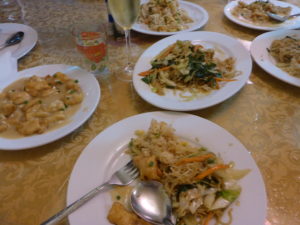
Back on board, checking our emails we found Alison and Randall had arrived in Tregoning on a mooring a few feet away, so more adventures are afoot methinks!
